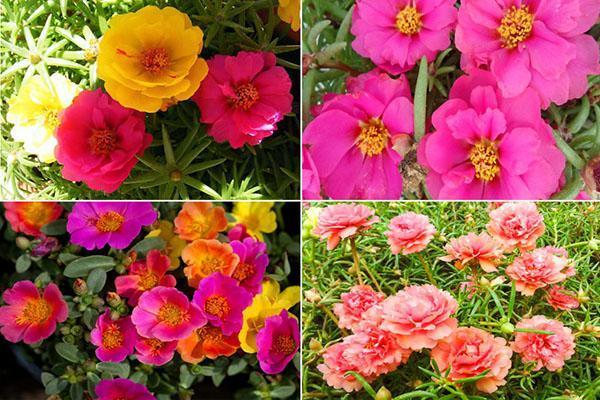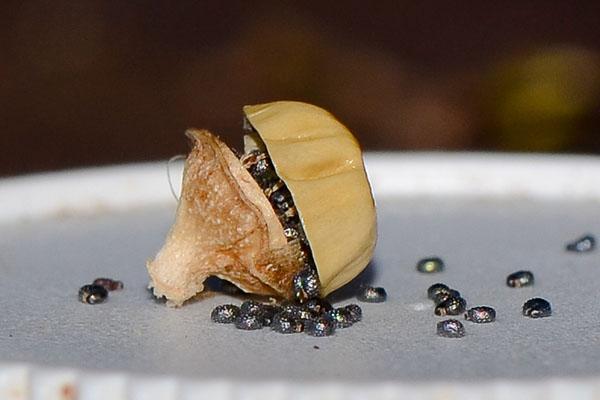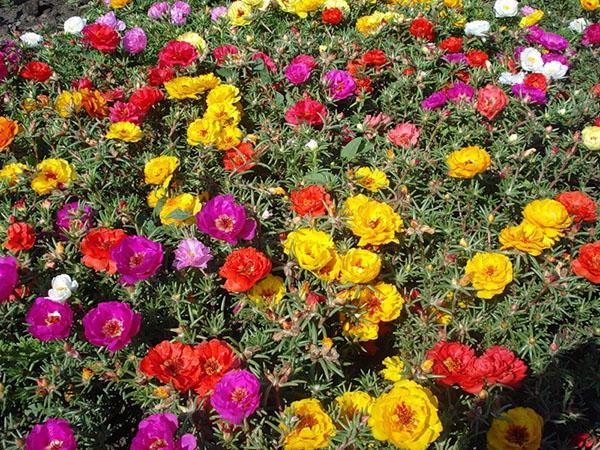Delightful species and varieties of purslane, but the choice is up to the gardener
 In landscape design, ground cover plants have a place of honor, as they bring a touch of home comfort to the exterior. The types and varieties of purslane are so diverse that you can endlessly experiment with them. The culture gets along well in the areas scorching by the sun. Therefore, it is boldly planted in open flower beds. In modern practice, an exclusive weed is used as a terry lawn. A purslane flower carpet (dandura is another name) is decorated with alpine slides and rockeries. To make them look as stylish as possible, you need to choose the right collection of varieties.
In landscape design, ground cover plants have a place of honor, as they bring a touch of home comfort to the exterior. The types and varieties of purslane are so diverse that you can endlessly experiment with them. The culture gets along well in the areas scorching by the sun. Therefore, it is boldly planted in open flower beds. In modern practice, an exclusive weed is used as a terry lawn. A purslane flower carpet (dandura is another name) is decorated with alpine slides and rockeries. To make them look as stylish as possible, you need to choose the right collection of varieties.
It is planted on dry, stony, and depleted soils. Applying too much fertilization can destroy the plant.
Types and varieties of purslane with large flowering

The unpretentious nature of the weed has become an acquisition for gardeners. Loggias and balconies are often decorated with garden purslane. It is sown in hanging planters either in containers. Border compositions with these flowers are one of the interesting design options for a personal plot. Read aboutcoreopsis! In addition, they can easily replace wilted crops, since they appear in the flowerbed later than everyone else.
In addition, they can easily replace wilted crops, since they appear in the flowerbed later than everyone else.
To grow a hundred specimens of dandur (purslane) in the garden, it is enough to sow 0.02 g of seeds, which ripen by the end of August or the beginning of September. Sowing work is carried out in April. As a result, the first shoots appear after 10 days. Often they need to be thinned out in 15-20 cm increments.
Now we will get acquainted with some popular varieties. The varieties of large-flowered purslane are presented to your attention. Fleshy curly stems reach 15 to 30 cm in length. Narrow leaves are located alternately to each other. The flowers grow up to 4-5 cm in diameter.  They open only in sunny weather, and their lifespan is one day. In addition to a varied palette of colors, they also come in unusual shapes. Terry buds are especially striking.
They open only in sunny weather, and their lifespan is one day. In addition to a varied palette of colors, they also come in unusual shapes. Terry buds are especially striking.
The many-faced Sonya
 Sowing seeds for seedlings is carried out in March. A superficial method is used. The container is covered with glass. Three months later, the seedlings are transferred to open ground. Abundant flowering begins in July and continues until the end of September. Sonia purslane flowers come in 4 shades:
Sowing seeds for seedlings is carried out in March. A superficial method is used. The container is covered with glass. Three months later, the seedlings are transferred to open ground. Abundant flowering begins in July and continues until the end of September. Sonia purslane flowers come in 4 shades:
- purple;
- scarlet;
- fiery yellow;
- white.
 At the same time, near the very middle, which is presented in the form of a spread out brush, brown spots flaunt. They resemble refined droplets. The surface of the petals has a satin texture, so it shimmers luxuriously in the sun.
At the same time, near the very middle, which is presented in the form of a spread out brush, brown spots flaunt. They resemble refined droplets. The surface of the petals has a satin texture, so it shimmers luxuriously in the sun.
The colorful purslane of Grandiflora is considered unusual. Its flowers are reminiscent of the magnificent ballerina tutu made of tulle. White and lemon varieties look especially elegant. Not deprived of the attention of gardeners and the pink variety, as well as the shade of fuchsia.
Flamenco reveals the true essence of greatness
 Although the culture grows well on sandy, rocky, and dry soils, it is extremely intolerant of acidified soils.At the same time, it is not destined to see the buds, if the florist has sown the Flamenco purslane on fertile land or in the shade. For him, the best place is the southern sections of the summer cottages. Then the herbaceous plant throws out charming flowers of 6 tones:
Although the culture grows well on sandy, rocky, and dry soils, it is extremely intolerant of acidified soils.At the same time, it is not destined to see the buds, if the florist has sown the Flamenco purslane on fertile land or in the shade. For him, the best place is the southern sections of the summer cottages. Then the herbaceous plant throws out charming flowers of 6 tones:
- yellow;
- ash pink:
- eggplant;
- variegated (white petals dotted with raspberry blotches / strokes);
- carmine;
- scarlet.
The structure of the flower is quite unusual. Each row lies on top of each other, forming a delightful volumetric illusion. And the wavy edges of the Flamenco terry purslane play subtly under the influence of a light breeze. These exquisite buds (6 cm in diameter) harmoniously adorn a fleshy 20 cm stem, which is densely covered with thorns.
Watering the flower bed is recommended in rare cases when the drought lasts more than 2-3 weeks. Everything is worth remembering that the culture begins to hurt and stops growing in highly moist soil.
Flowers also have a pun
 This hybrid is advised to be planted as a soil annual. Thanks to the spreading stems of a dark red hue, which grow up to 10-15 cm, they quickly fill the area allotted to them. Purslane Kalambur is suitable for well-drained land, it can be sandy or rocky. Terry flowers 3-4 cm in diameter bloom in June. They serve as an excellent decorative carpet because they have:
This hybrid is advised to be planted as a soil annual. Thanks to the spreading stems of a dark red hue, which grow up to 10-15 cm, they quickly fill the area allotted to them. Purslane Kalambur is suitable for well-drained land, it can be sandy or rocky. Terry flowers 3-4 cm in diameter bloom in June. They serve as an excellent decorative carpet because they have:
- a diverse palette: purple, yellow, pink and red;
- terry structure - they consist of many small cut petals, which are decorated with scarlet specks in the central zone;
- the embossed middle of an orange shade (it is slightly depressed inward).
 Large-flowered purslane (terry mixture) with its colors pleases gardeners before the first frost. Especially such an extravaganza of bright colors is observed when the weather is warm and sunny.
Large-flowered purslane (terry mixture) with its colors pleases gardeners before the first frost. Especially such an extravaganza of bright colors is observed when the weather is warm and sunny.
If desired, the florist can fertilize the garden bed, but only with mineral preparations. Since a small amount of organic matter destroys the planting in an instant.
Snow white carpet in a royal setting
 The style of classics and minimalism are closely related. In both the one and the other, the idea of strictness is intertwined with the policy of "nothing more". If the owners of the dacha adhere to such standards, then White purslane is suitable for their front garden.
The style of classics and minimalism are closely related. In both the one and the other, the idea of strictness is intertwined with the policy of "nothing more". If the owners of the dacha adhere to such standards, then White purslane is suitable for their front garden.
On its fleshy shoots there are "live" needles. These stems (20 cm) are crowned with luxurious flowers up to 6 cm in diameter. They are somewhat similar to the Air Marshmallow variety. When closed, the buds imitate lily jugs. The highlight of the flower is the contrasting yellow center, which stands out strikingly against the snow-white background.
 The purslane hybrid Prince's rug looks amazing on the lawn. In addition to snow-white flowers, he throws out crimson-red corollas. The corrugated edges of the petals leave an indelible impression in the soul of passers-by.
The purslane hybrid Prince's rug looks amazing on the lawn. In addition to snow-white flowers, he throws out crimson-red corollas. The corrugated edges of the petals leave an indelible impression in the soul of passers-by.
You can plant plants in empty areas of the flower bed, where nothing else survives. Moreover, the bush, which grows up to 40 cm, is ideal for group plantings as a background canvas.
Vegetable, and thus edible varieties
Having got acquainted with large-flowered species and varieties of purslane, you should pay attention to others. These sour greens are eaten and also used for medicinal purposes.
Firefly for health
 Its leaves, as well as shoots, become a glimmer of hope for those suffering from diabetes, various kidney and liver diseases. Regular consumption of luscious foliage helps patients to successfully fight the disease. The plant has the following external characteristics:
Its leaves, as well as shoots, become a glimmer of hope for those suffering from diabetes, various kidney and liver diseases. Regular consumption of luscious foliage helps patients to successfully fight the disease. The plant has the following external characteristics:
- creeping stem that reaches 50 cm in length;
- the socket is slightly raised;
- has a fleshy ovoid foliage with a yellowish-green tint.
Firefly purslane is popular for its incredible yield: from 1 m² you can collect up to 2.5 kg of priceless raw materials. The weight of one bush is 250 g. At the same time, its taste adds to salads, borscht, marinades and meat / fish dishes with a special sourness.
It has a slightly spicy taste, so it is often canned. Seasoning is used both fresh and salted.
Poppy is a holiday for someone
 Salads, soups and sauces will become much healthier with Poppyseed purslane. The variety is distinguished by its special unpretentiousness to the soil. In addition, it prefers only a warm climate. In such conditions, the shoots of the culture grow up to 30-35 cm. They are heavily covered with appetizing leaves, which are:
Salads, soups and sauces will become much healthier with Poppyseed purslane. The variety is distinguished by its special unpretentiousness to the soil. In addition, it prefers only a warm climate. In such conditions, the shoots of the culture grow up to 30-35 cm. They are heavily covered with appetizing leaves, which are:
- crispy;
- smooth;
- small;
- glossy.
Only young seedlings are cut. They are harvested 25-30 days after the first shoots appear. The mass of one bush is about 100 g. Fresh is advised to eat only the upper part of the outlet.
For the preparation of all other culinary masterpieces, other parts of the garden purslane Macovei are used. They are fried and stewed in olive oil. Moreover, the leaves are crumbled into salads with tomatoes and cucumbers.
Paradox in nature
 Its luxurious top rises above the ground by 18-21 cm. One plant weighs up to 80 g. From 1 m² the gardener will collect 900 g of fresh herbs. It contains many minerals and vitamins. Due to the fact that purslane vegetable paradox is rich in ascorbic acid, it has a sour taste that leaves a spicy, even pungent, aftertaste. To grow such a useful delicacy, you should take into account the peculiarities of planting:
Its luxurious top rises above the ground by 18-21 cm. One plant weighs up to 80 g. From 1 m² the gardener will collect 900 g of fresh herbs. It contains many minerals and vitamins. Due to the fact that purslane vegetable paradox is rich in ascorbic acid, it has a sour taste that leaves a spicy, even pungent, aftertaste. To grow such a useful delicacy, you should take into account the peculiarities of planting:
- select only sunny areas;
- do not overmoisten the soil;
- sow to a depth of 0.5 cm;
- thin out the first shoots;
- cut off before flowering (2-3 times).
This plant is recommended to pickle. The prepared spice is surprisingly appealing to meat or fish dishes.
More than one year
 The unusual herbaceous culture is that there is also a perennial purslane - an ampelous variety. Nevertheless, the harsh climate of the northern latitudes does not allow growing it in the open field. It just freezes and turns into an ordinary annual. While some practice sowing seeds in pots / containers and growing at home. In the fall, it is brought into the room, trying to constantly keep the soil moist. In the spring, the specimen needs enhanced feeding. As soon as it is taken out into the street, then all the stems are immediately cut off so that new ones can form.
The unusual herbaceous culture is that there is also a perennial purslane - an ampelous variety. Nevertheless, the harsh climate of the northern latitudes does not allow growing it in the open field. It just freezes and turns into an ordinary annual. While some practice sowing seeds in pots / containers and growing at home. In the fall, it is brought into the room, trying to constantly keep the soil moist. In the spring, the specimen needs enhanced feeding. As soon as it is taken out into the street, then all the stems are immediately cut off so that new ones can form.
This overview of the most popular types and varieties of purslane is rather succinct. In fact, there are hundreds of hybrids of each. However, the main characteristics remain unchanged.